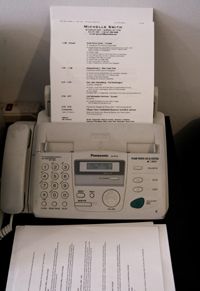Basic Idea Behind Fax Machines
Most of the early fax machine designs involved a rotating drum. To send a fax, you would attach the piece of paper to the drum, with the print facing outward. The rest of the machine worked something like this:
- There was a small photo sensor with a lens and a light.
- The photo sensor was attached to an arm and faced the sheet of paper.
- The arm could move downward over the sheet of paper from one end to the other as the sheet rotated on the drum.
In other words, it worked something like a lathe.
Advertisement
The photo sensor was able to focus in and look at a very small spot on the piece of paper -- perhaps an area of 0.01 inches squared (0.25 millimeters squared). That little patch of paper would be either black or white. The drum would rotate so that the photo sensor could examine one line of the sheet of paper and then move down a line. It did this either step-wise or in a very long spiral.
To transmit the information through a phone line, early fax machines used a very simple technique: If the spot of paper that the photo cell was looking at were white, the fax machine would send one tone; if it were black, it would send a different tone (see How Modems Work for details). For example, it might have sent an 800-Hertz tone for white and a 1,300-Hertz tone for black.
At the receiving end, there would be a similar rotating-drum mechanism, and some sort of pen to mark on the paper. When the receiving fax machine heard a 1,300-Hertz tone it would apply the pen to the paper, and when it heard an 800-Hertz tone it would take the pen off the paper.
On the next page, we'll talk about modern fax machines.
